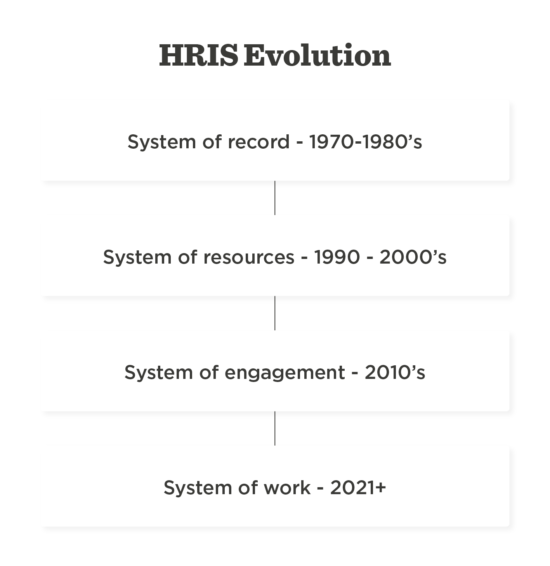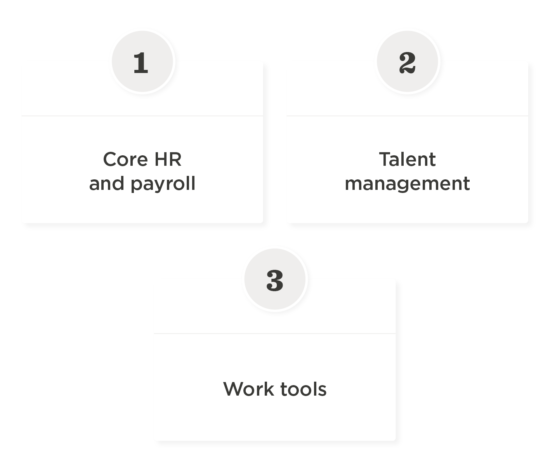After COVID-19, nothing will be the same–including workplaces. Some organizations may shift entirely to remote operations, and others may use a hybrid work approach. In contrast, others will return entirely in-person but will need increased distancing to address safety concerns.
We must adapt our workplace models and our mode of working to meet these new remote-driven operations. Having the right tech stack is one way to ensure that you can keep operating smoothly while also supporting employees, engaging with them, and creating a successful employee experience.

The impact of employee experience on tech
“Employee experience is turning the tech market inside out,” according to Josh Bersin, HR analyst and founder of the Josh Bersin Academy. “Every company is reinventing its employee experience, so they need tools that simplify, automate and digitize everything…HR needs creator tools as well as off-the-shelf systems. Collaboration and productivity systems need to be integrated into the daily HR transaction systems, making them easier to use, personalized, data-driven and AI-enabled, so employees can do their jobs and manage their work lives.”
One of the critical components of your employee experience is access to an empowering and engaging tech stack–a set of complementary technology used to run your business. The power of a great tech stack is that the right set of tools can cooperate to help you and your employees manage work as efficiently as possible.
In this guide, we’ll look at why your tech stack is more important than ever before, and we’ll also provide three categories you should consider when evaluating your tech stack to make it as useful as possible for your employees and your operation.
Why is your tech essential to your success?
The COVID-19 pandemic highlighted many new opportunities related to work, including the reality that remote work is a viable option.
“After spending the last two decades building amenity-filled campuses that maximize the ‘collisionability’ of talent and ideas while enticing their workers to stay in the office for as much time as they can, COVID-19 has shown leading-edge technology companies that their workers can be just as productive—or in some cases, even more so—when they stay at home,” according to Harvard Business Review.
While it’s true that some companies adjusted quickly to remote work, other companies found that due to a lack of technology, they faced significant struggles, particularly with keeping remote employees engaged. Indeed, it’s impossible to make a remote approach workable without the right collaboration, creativity, and productivity technologies.
The value in having the right technology when you need it is not just a theory; HiBob has seen companies experience direct benefits when updating their tech stack. When our team surveyed 2,000 full-time workers across the US and UK, their responses indicated that the companies which added HR tech to their remote tech stack during the pandemic saw higher job satisfaction and a more productive work-from-home experience.
For businesses looking to learn from what the pandemic taught us about operational survival, a key consideration is the viability of your tech stack. Do you have what you need to not only survive the pandemic-created remote workplace, but do you also have what it will take to thrive in the future?
What needs should your tech stack address?
The workplace technology options may feel overwhelming. Faced with too many choices, it’s common that HR may be reluctant to act. At the center of your technology goals should be an understanding that your tech stack can–and must–help facilitate a better employee experience.
As a result of our transition to a remote/hybrid work environment, the right tech stack is more important than ever. Of course, employees and managers need access to a tech stack that helps provide the information and documents they need. But a tech stack can offer much more.
In addition to information and documentation, your tech stack should ensure employees have a sense of belonging, feel supported, and benefit from a personalized experience. How you use your technology should foster collaboration, facilitate recognition, and reinforce your culture.
“When we look at modern, mid-size, and global companies and think about the employee experience, we’re talking about every interaction an employee has with your business’s HR function—from pre-boarding to offboarding (and everything in between),” according to Ronni Zehavi, our CEO. “However, this isn’t limited to standard HR tasks like time and attendance, payroll, and feedback. While these core tasks are vitally important, we also think about culture, inclusion, productivity, and wellbeing.”
There’s been a steady evolution of HR technology. As Bersin highlights in HR Technology 2021: The Definitive Guide, the shift has been in system capabilities as well as in the how these systems are used. In the 1970s, HR tech included systems of record that automated paper transactions.

In the 1990s and 2000s, technology evolved from automation and recordkeeping to software focused on talent—including learning management, engagement surveys, and employee self-service.
Today, HR technology has reached a new level with systems focused on engagement using a single user interface intended to engage employees and help companies with digital transformation. That’s what we intend to explore.
Tech stack to support the employee experience
To determine what your tech stack should include, start by looking at what your organization currently uses—including any software on the cloud, mobile apps, desktop software, and other legacy systems. Do you have what you need to cover critical operational areas that impact the employee experience for a remote workforce?
If not, it’s time to consider the available options. Given the variety of today’s technology, it helps if you examine your tech stack based on three broad categories that are most relevant to the employee experience:

Core HR and payroll
As part of your core HR and payroll tech, your tech stack should address employee self-service needs such as time and attendance, scheduling, benefits, and payroll-related tasks. These systems can help streamline processes and optimize employee productivity by providing everyone with access to the employment-related information they need.
In HR Technology 2021: The Definitive Guide, Bersin notes a new approach to this category. Core HR applications are no longer solely focused on HR processes but have evolved to serve as vital management tools. He highlighted our very own Bob as one HCM platform that delivers on this promise.
“One of the more innovative HCM platforms is Bob. [The system] is designed as a management platform first and an HR platform second. Its entire design is focused on what information managers, employees, and executives need. And clients who use the solution personalize it, calling it by its name….[bob] represents a new approach to core HR, one which I believe every major vendor will have to address. Bob is a management tool, not an HR tool.”
Digital applications for core HR tasks help employees and employers alike avoid inefficient processes. Ideally, by looking at core HR as a management tool, you can find technology that enables you to streamline tasks and information in one easy-to-reference location.
Talent management
In the area of talent management, your tech stack should contain everything related to attracting, recruiting, and retaining quality hires. These are the applications that overtly and covertly support the employee experience and boost your organizational culture.
As you consider the employee experience you hope to create, ask these questions about your talent management tech stack:
- Do we use technology to provide exceptional service for job searchers?
- How does our tech stack support candidates who want to apply to join our company?
- Are we using an onboarding system that helps us engage employees before their first day on the job?
- How does our technology assist employees in achieving their professional development goals?
- Can we increase employee wellbeing through our tech stack?
- Do our software solutions provide options to recognize and reward employees for their efforts?
Savvy HR leaders are looking to create a tech stack that enhances and supports their talent management strategy. Whether it’s through one system or by combining individual platforms, it’s now possible to find the tech you need to deliver an outstanding employee experience.
Work tools
“Among all the things we must think about (diversity, pay equity, leadership gaps, performance management, wellbeing, culture, and more), perhaps the most important is helping define how work gets done,” according to Bersin.
Indeed, as you’re considering your tech stack, a top concern is to look at what can help your employees get the work done—in a way that supports your culture and the employee experience. These are the tools that enable communication and collaboration within and across the organization. These are the apps that provide ways to manage goals and tasks.
With so many remote work collaboration tools to choose from, you have to explore the options to see what products work for your organization. You’ll find some recommendations for innovative work apps on our list of top tech work tools. Each of these tools offer ways to empower your remote teams and help them feel connected and productive outside.
One example of a new work tool is Donut, an app that, as their website says, “lets colleagues collect around the water cooler, anywhere.” This app randomly pairs employees and schedules virtual coffee or lunch meetings for them. (Just because employees are working remotely doesn’t mean they can’t build new work relationships.)
Work tools such as video platforms, chat apps, online conferences, and other communication channels are great for connecting people. But as you consider what to add to your tech stack, make sure the tools you use also help strengthen your culture—regardless of employee location.

Three keys to assessing your tech stack options
Once you’ve determined what your tech stack should include to address core HR, talent management, and work tool needs, make sure you evaluate each solution for business integration and relevancy.
Evaluate the solution based on your size and business model. Employee and operational needs aren’t the same for a small business and a large corporation. For example, if you’re a small business that rarely recruits and hires new employees, you probably don’t need a tech stack that includes a robust recruiting platform. However, just like a larger company, you may benefit from a system that allows you to reward and recognize your employees easily or offer them micro-learning development opportunities.
Keep in mind that your tech stack needs will evolve as you grow. What works when you have 50 employees might break when you reach 150 employees. Similarly, what works for a startup may not work in a more traditional organization. As you compare options, ask for recommendations from businesses similar in size and style to your own. These referrals can inform your decisions based on practical first-hand insights.
Ensure integration is an option. For a streamlined end user experience, today’s digital workplaces require integrated applications. When systems combine, they make it easier for employees to collaborate, share information, and get work done.
Not every system will integrate but as much as possible, look for partnerships that will allow you to create a complete system that supports the employee experience. Your tech stack can be the spark that creates opportunities and opens doors for what HR, the organization, and employees can achieve when they have the right tools.
Be a decision-maker when it comes to your tech stack. Some HR leaders may shy away from making technology recommendations and decisions. It’s understandable–applications, systems, and integrations are complex. But don’t let your lack of tech expertise inhibit you. When it comes to the employee experience, HR professionals are the experts. Use that expertise to empower your tech decisions.
“Take the power back from your IT folks. We let IT make HR Tech decisions, and they have no idea what we need,” says HR practitioner and expert Tim Sackett. “We need to stop that. It’s the worst thing that happens to an HR team when IT selects your tools and has absolutely no idea what HR needs. Finance never would allow IT to select the finance software; why does HR allow this?”

Recommended For Further Reading
Conclusion
As organizations worldwide continue to adjust to the pandemic and its impact on the way we work, two things are evident: hybrid work is here to stay, and the tech stack organizations use must evolve. To succeed, companies must invest in tech tools that fit into the existing stack to make their organizations can perform better while supporting employees’ needs.
Companies that adapt and evolve their tech stack in these ways will benefit from streamlined operations and from employees who feel understood. By deploying the right core HR, talent management, and work tools for your operation, it’s possible to empower the employee experience in a way that drives results and brings your business to new levels.
Meet Bob
The right technology is essential.
More and more companies are putting technology at the top of their list when improving the employee experience. To attract and keep top talent, organizations must make it easy for employees to interact and engage with their work and company culture.
Here are some of the ways HiBob’s platform can help you engage new hires, re-engage current people, and attract better people by putting your technology to use:
- Collaboration tools
- Surveys
- Checklists
- Time and attendance
- Appreciation tools
- Performance
